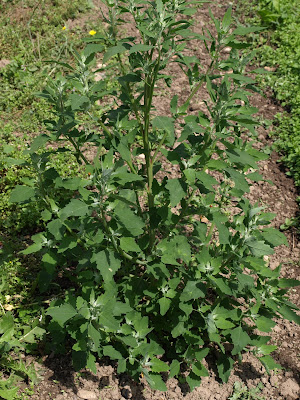Fat Hen (Chenopodium album) is an annual plant belonging to the Chenopodiaceae family. Other common names include lambs quarters, goosefoot and pig weed. The leaves have the shape of a goose foot, hence the common name 'goosefoot'. It is a native British plant but is also found in Europe, Asia, Australia and North America. It can be seen on or around the edges of arable fields, hedgerows and waste land. It frequently comes up in our vegetable patch.
Growing methods
Sow seeds in spring in situ. Seeds will usually germinate within a few days and the plant is fast growing. Fat hen is in flower from July to October in Britain. Seeds are produced on the plant from August to October. It is wind pollinated, prefers full sun and will thrive in long summer days. Plants that emerge earlier in the year will be leafy and large. It is frost sensitive and rarely survives the winter. Fat hen will self seed and come up by itself in subsequent years. Seed can remain viable in the soil for many years.
Other uses
Fat hen has been used in folk medicine and grown as a feed crop for animals. The crushed fresh roots and the water residue from seed rinsing can be used as a soap. A green dye can be made out of the green shoots.
Raw edible parts
The young leaves and shoots, tops of mature plants, the flowers and sprouted seed are all edible raw but probably in moderation (see Issues). The seed, which is similar to quinoa, can also be dried and ground into a meal. It is best to rinse it thoroughly to remove the saponins before sprouting. Use the resulting soapy water for washing skin and clothes.
The leaves can be cooked and used as spinach. The young inflorescences (cluster of flowers on the stem) can be cooked and used like broccoli.
Fat hen has matt blue-green leaves which repel water. The whole plant has a faint cabbage-like smell and taste to it.
Issues
Fat hen contains saponins which are glycosides that froth up like soap. It also contains oxalic acid and can contain nitrates depending if the soil is nitrogen-rich or not.
 |
| Fat hen growing in the vegetable patch |
Growing methods
Sow seeds in spring in situ. Seeds will usually germinate within a few days and the plant is fast growing. Fat hen is in flower from July to October in Britain. Seeds are produced on the plant from August to October. It is wind pollinated, prefers full sun and will thrive in long summer days. Plants that emerge earlier in the year will be leafy and large. It is frost sensitive and rarely survives the winter. Fat hen will self seed and come up by itself in subsequent years. Seed can remain viable in the soil for many years.
Other uses
Fat hen has been used in folk medicine and grown as a feed crop for animals. The crushed fresh roots and the water residue from seed rinsing can be used as a soap. A green dye can be made out of the green shoots.
Raw edible parts
The young leaves and shoots, tops of mature plants, the flowers and sprouted seed are all edible raw but probably in moderation (see Issues). The seed, which is similar to quinoa, can also be dried and ground into a meal. It is best to rinse it thoroughly to remove the saponins before sprouting. Use the resulting soapy water for washing skin and clothes.
The leaves can be cooked and used as spinach. The young inflorescences (cluster of flowers on the stem) can be cooked and used like broccoli.
Fat hen has matt blue-green leaves which repel water. The whole plant has a faint cabbage-like smell and taste to it.
Issues
Fat hen contains saponins which are glycosides that froth up like soap. It also contains oxalic acid and can contain nitrates depending if the soil is nitrogen-rich or not.
No comments:
Post a Comment